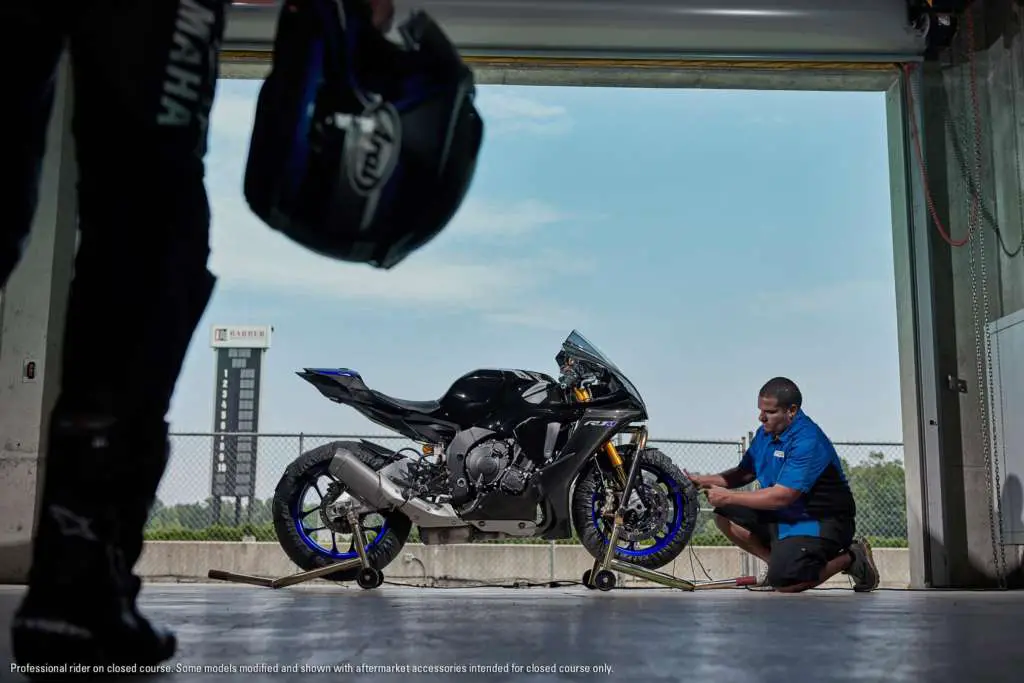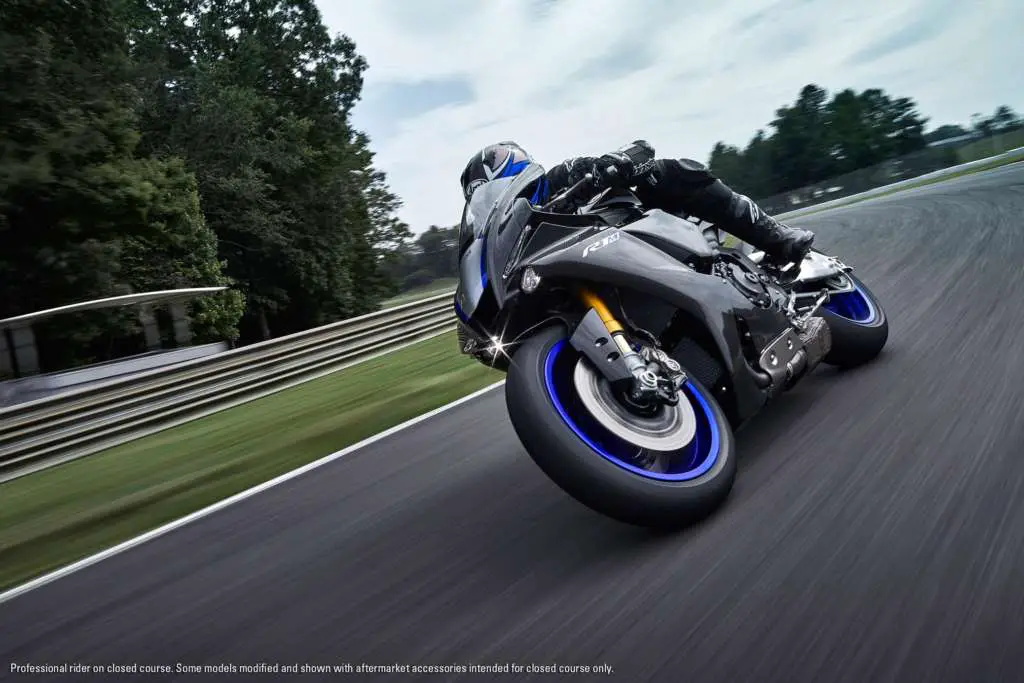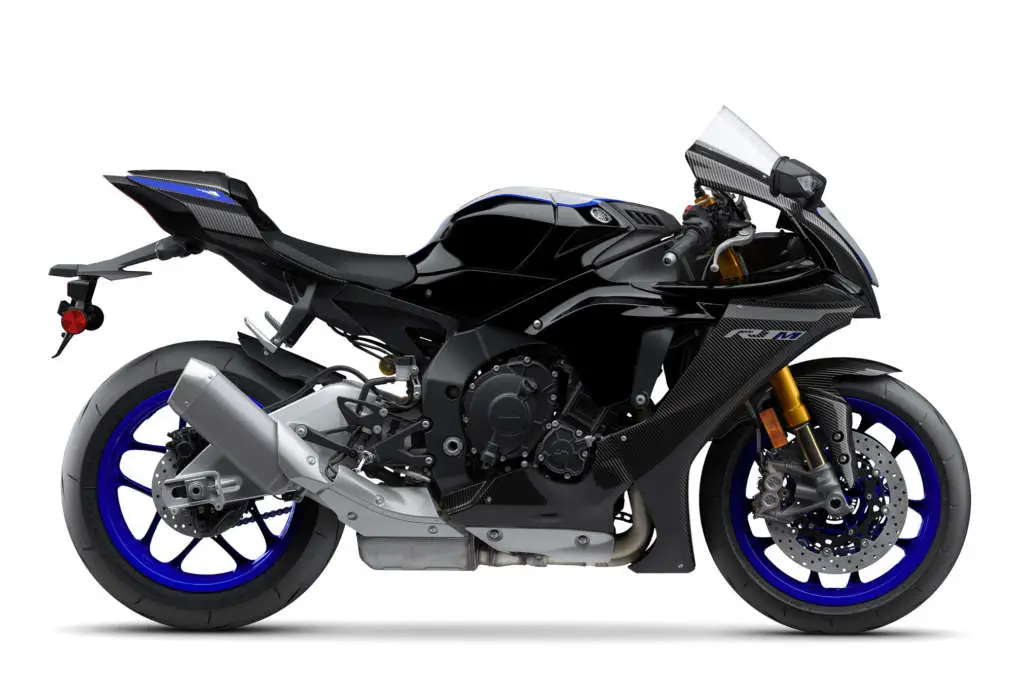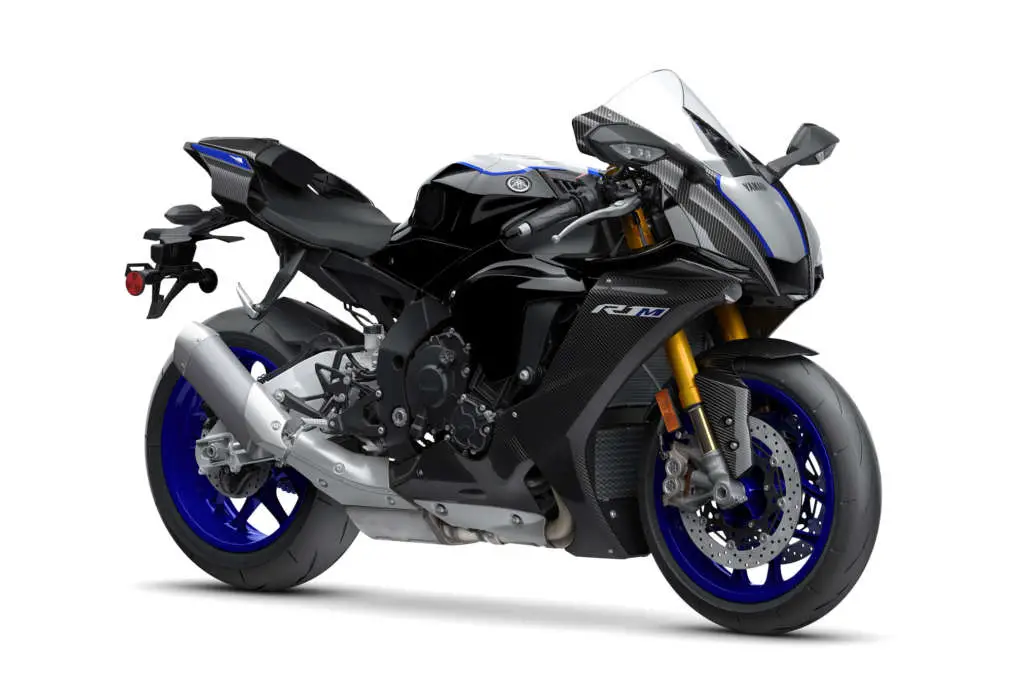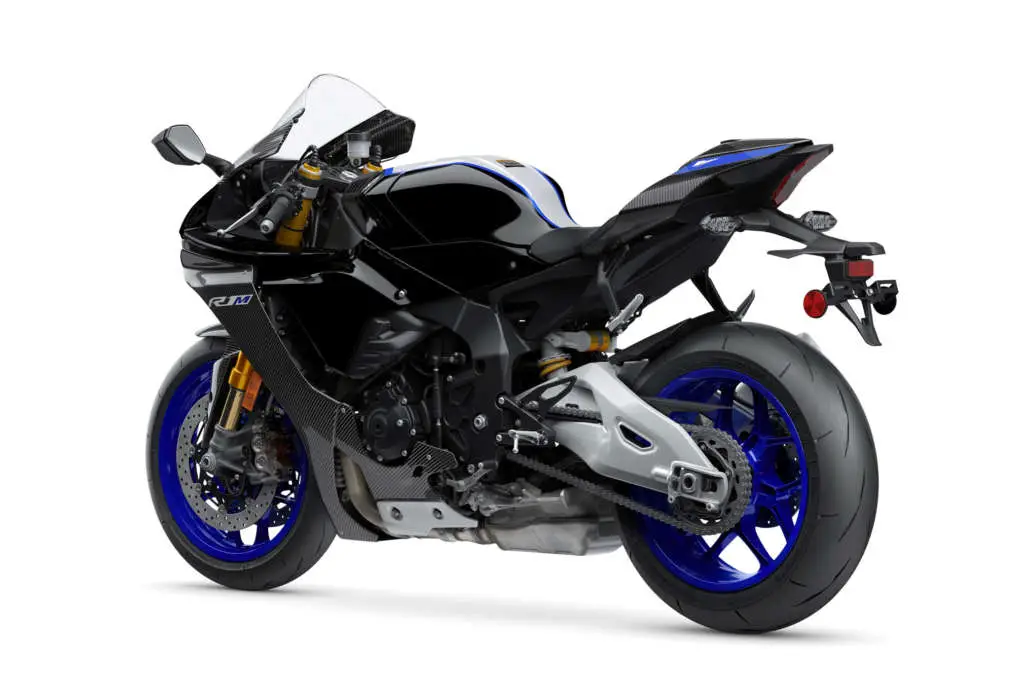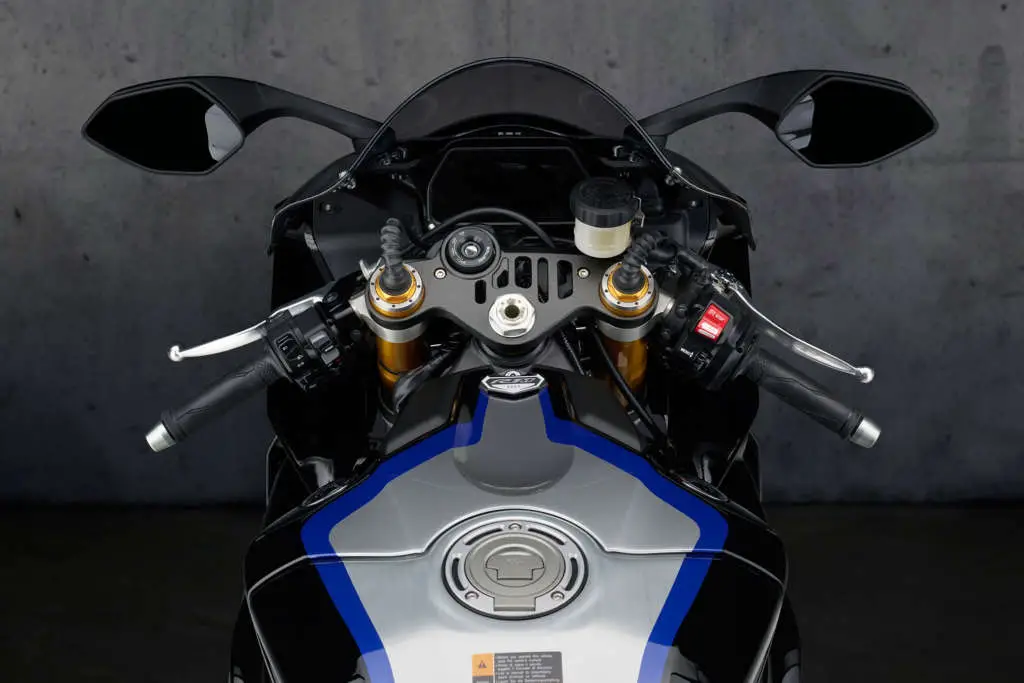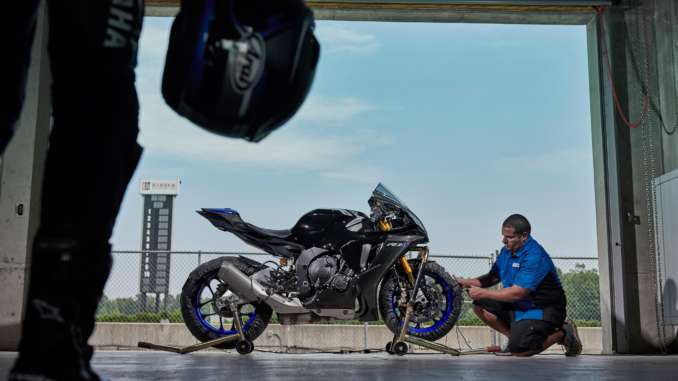
R HISTORY. YOUR FUTURE. WE R1.
2020 Yamaha YZF-R1M:
Featuring next‑generation R‑Series styling, sophisticated electronic control, enhanced braking and suspension performance, and a refined crossplane engine.
Your whole motorcycling career has been building up to this moment. And with the new YZF-R1M you can be sure that you are in possession of the most advanced Yamaha production track bike of all time. Take a look at the new more aerodynamic M1-inspired carbon bodywork and it’s clear that this race-focused motorcycle is constructed like no other machine.
R history. Your future.
With its state-of-the-art Öhlins Electronic Racing Suspension (ERS) – including new NPX anti-cavitator gas front forks – as well as new Brake Control (BC) system and new 3-mode Engine Brake Management (EBM) system, the YZF-R1M is ready to push the boundaries.
And its mind-blowing array of wirelessly tuneable electronic control technologies give you the highest degree of confidence.
Yamaha has a rich heritage of building the most sought-after supersport motorcycles designed to deliver the pinnacle of performance on and off the track. Based on the legendary YZF-R1, the 2020 R1M goes a step above: standard features include premium Öhlins Electronic Racing Suspension (ERS), a standard Communication Control Unit (CCU) for data and lap time acquisition with your smartphone, and carbon fibre bodywork. From crossplane crankshaft engines to revolutionary electronics such as the six-axis Inertial Measurement Unit (IMU), Yamaha’s historical achievements have become the future of R World.
YZF-R1M
Virtually every part of the latest YZF-R1M has been developed with the knowledge gained though the company’s race teams over the last seven decades – including WSBK and MotoGP. Its new M1-style carbon fairing gives over 5% more aerodynamic efficiency – and the sophisticated electronic control technologies and Electronic Racing Suspension were developed on the race track.
New YZF-R1 and YZF-R1M: R history. Your future.
Yamaha has been racing and winning ever since the company manufactured its very first motorcycle. Just 10 days after Yamaha Motor Company was founded on July 1st 1955, the YA1 – Yamaha’s very first model – claimed top place on the podium in the prestigious Mount Fuji ascent race. Since that day racing has been an integral part of the company’s DNA, and seven decades later this burning desire to compete and win is what defines Yamaha.
Whether racing a 125cc 2-stroke up a mountain in Japan or fighting for the lead in WSBK and MotoGP, the company’s absolute commitment to racing is second to none, and this devotion to competition pushes Yamaha to create some of the most inspiring, exciting and technologically sophisticated supersport bikes.
Today’s R-Series supersport segment features the widest line up of the most outstanding motorcycles ever built by Yamaha. Developed using the very latest technology from Yamaha’s WSBK winning race bikes – and inspired by the advanced designs seen on the M1 MotoGP bikes – each R-Series model from 1000cc to 125cc has the potential to power today’s thrill-seeking supersport riders into R-World, where boundaries are constantly pushed and ambitions are achieved.
Racing is and always will be the driving force that enables Yamaha to make motorcycles that lead the way, and for 2020 Yamaha introduce the new YZF-R1 and new YZF-R1M supersport models.
2020 Yamaha YZF-R1M Totalmotorcycle.com Key Features
At a glance
- New aerodynamically efficient M1-inspired bodywork
- Premium Öhlins Electronic Racing Suspension (ERS)
- New Öhlins NPX anti-cavitation gas forks
- New 2-mode Brake Control (BC) system
- New 3-mode Engine Brake Management (EBM) system
- High efficiency 998cc EU5 engine
- New carbon tail section, carbon bodywork & mudguards
- New Bridgestone Battlax RS11 tyres – 200 wide rear
- Production number engraved on special R1M plaque
- Lightweight ride-by-wire APSG throttle
- Optimised Launch Control (LCS) system
- Exclusive CCU enables wireless trackside tuning
KEY DIFFERENCES BETWEEN R1M & R1
- Premium Öhlins Electronic Racing Suspension (ERS)
- Communication Control Unit (CCU) – Datalogger & vehicle info via Wi-Fi (standard equipment)
- Wider 200 series rear tire (200/55ZR17)
- Carbon fibre bodywork
NEW FOR 2020
- Redesigned cylinder head, fuel injectors, finger-follower rocker arms and camshaft profiles
- New ride-by-wire system with YCC-T
- Brake Control (BC) and Engine Brake Management (EBM) for a total of seven electronic control rider aids
- Öhlins ERS NPX front fork with integrated gas cylinder and optimized rear shock settings
- Next-generation R-Series redesigned bodywork with outstanding aerodynamic efficiency
- Carbon fiber tail cowl
- Bridgestone RS11 Battlax Racing Street tires with updated tread design
- New front brake pad friction material for excellent control while braking
2020 YZF-R1M
The YZF-R1M is the definitive Yamaha supersport motorcycle that has established a hard-won reputation as one of the most sophisticated and capable race bikes – as well as being regarded as the ultimate machine for passionate riders.
With its cutting edge electronic control technology and aggressive M1-inspired carbon bodywork, this exclusive track motorcycle offers every rider the opportunity to experience genuine factory superbike performance. Furthermore, with its highly advanced CCU and Öhlins Electronic Racing Suspension (ERS), track day riders and racers are able to achieve the ultimate engine and chassis set-up without the need for expensive and highly specialist equipment. This in turn gives a greater number of riders the very real chance to realise their full potential and enjoy one of the greatest extreme sports ever invented!
The 2020 YZF-R1M benefits from a range of exclusive upgrades, in addition to featuring all of the changes that are described in the previous section on the YZF-R1.
New Öhlins ERS NPX gas pressurised forks
The YZF-R1M uses the latest generation Öhlins Electronic Racing Suspension (ERS) system that offers the highest level of adjustability for the ultimate control together with race-winning performance.
The 2020 model benefits from the addition of the latest Öhlins ERS NPX gas pressurised forks. These feature a small gas cylinder integrated within the fork axle bracket, and by exerting 0.6 Mpa of internal pressure, the gas reduces fork oil cavitation that is caused by negative pressure that occurs on the rebound stroke.
The new Öhlins ERS NPX gas pressurised forks contribute significantly towards achieving a more consistent damping force for increased levels of chassis control together with higher handling agility and reduced lap times.
To complement the improved performance of the new NPX front forks, the Öhlins Electronic rear suspension benefits from a modified preload setting.
New lightweight carbon tail cowl
New and exclusive for 2020 is a lightweight carbon tail cowl that complements the new M1-style carbon fairing and front fender. This use of ultra-light bodywork underlines the YZF-R1M’s exclusivity, and contributes towards the machine’s extremely light and responsive handling performance.
Stamped with its unique production number
The YZF-R1M is without a doubt the most exclusive supersport model in Yamaha’s line up, and to recognise the pride of ownership engendered by this motorcycle, Yamaha are individually numbering each machine as it comes off the production line.
YZF-R1M Apps: A virtual Yamaha pit crew!
Yamaha has developed a number of apps for the YZF-R1M that give every rider full access to the sophisticated technology associated with factory teams. Intuitive software makes these apps straightforward to use and easy to operate, and with their ability to instantly adjust the YZF-R1M’s advanced electronic rider control settings, these apps are like having a personal Yamaha pit crew.
YRC Setting App
The YRC Setting app enables YZF-R1M users to create their own personalised riding modes by adjusting the seven electronic control systems. Riders of all abilities can select their preferred level of support for each mode, and in some cases it is possible to turn off selected electronic controls. The system is quick and easy to use, and gives users the ability to fine-tune their motorcycle so it behaves in a way that suits their own personal preferences and riding conditions.
Y-TRAC App
Y-TRAC is Yamaha’s Telemetry Recording and Analysis Controller, and it enables users to access the YZF-R1M’s CCU and download a range of data to a mobile device. Using Y-TRAC it’s possible to view and replay log files in real time on a Google Maps® image of a race track, as well as analyse and compare everything from engine rpm and lean angle through to acceleration G forces, and also see when various electronic rider controls were activated.
YZF-R1M New Features
- Highly sophisticated Öhlins ERS NPX gas pressurised forks
- Lightweight carbon tail cowl
- Aggressive new M1-style carbon cowling
- Stamped with its unique production number
- Updated Y-TRAC and YRC settings apps
- Fully integrated bodywork for improved rider/machine unity
- Aerodynamic efficiency increased by over 5%
- Reinforced feeling of quality and M1 DNA
- New 2-mode Brake Control (BC) cornering ABS
- New 3-mode Engine Brake Management (EBM)
- Optimized Launch Control System (LCS)
- New APSG ride-by-wire throttle
- Enhanced combustion efficiency and high rpm performance
- Increased braking performance
- New settings for steering damper
- Latest Bridgestone Battlax RS11 tyres with 200-section rear
- Uprated TFT instruments with BC and EBM indicators
- EU5 compliant engine
YZF-R1M Key Features
- State-of-the-art Öhlins Electronic Racing Suspension (ERS)
- Exclusive design with carbon and polished components
- Carbon front fender
- Communication Control Unit (CCU) with wireless remapping capabilities
- 998cc 200PS crossplane 4-cylinder engine
- 6-axis IMU with Gyro/G sensors for 3D motion data
- Power Delivery Modes (PWR)
- Quick Shift System (QSS)
- Banking sensitive Traction Control (TCS) / Slide Control (SCS)
- Front Lift Control (LIF) and optimized Launch Control System (LCS)
- Short wheelbase aluminium Deltabox frame
- Upward truss type swingarm
- Magnesium rear frame
- Exclusive entry to the European YRE events
Colour
Silver Blu Carbon BWM2/Carbon
2020 YZF-R1M reservation system
Yamaha will be operating an online reservation system for all YZF-R1M orders. The system will go live on July 25th 2019, and customers will be able to reserve their machine and also choose their preferred Yamaha dealer. Full details will be announced at the end of July. Please contact your local Yamaha distributor for more detailed information and retail price.
Yamaha Racing Experience
During 2020 the exclusive Yamaha Racing Experience (YRE) will be taking place at selected European racing circuits, where owners of the 2020 YZF-R1M will be offered technical support and advice, and will have the opportunity to learn about personalized set ups and meet some of Yamaha’s official riders.
Yamaha Genuine Accessories
Yamaha offer a wide range of Genuine Accessories designed for the YZF-R1 and YZF-R1M including beautifully crafted aluminium billet parts, performance parts, slip-on mufflers and service items – as well as exclusive bolt on accessories that enable every rider to personalize their bike.
Riders looking for enhanced power with reduced weight can fit the Akrapovič exhaust system that’s been specially developed for the latest YZF-R1 and YZF-R1M. With its more aggressive exhaust note and high quality construction, this titanium system is a must-have for performance minded riders, and is fully EU5 compliant. There will also be a special Akrapovič exhaust for closed circuit use only that is designed exclusively for track riders looking to explore the full potential of the new engine.
The Genuine Accessories line also includes endurance and sprint screens as well as crash sliders, along with a whole new selection of quality components that sharpen the looks, style and protection of these legendary supersport bikes.
New products are being continuously developed, and the Yamaha Genuine Accessories website is updated as soon as a new item is available. Yamaha is currently finalising the specifications and content of a range of new Accessory Packs designed for the R-series models, and full information will be made available prior to their launch in late 2019.
GYTR High specification racing components
Owners of the 2020 YZF-R1 and YZF-R1M can expect to receive some exciting news from the GYTR (Genuine Yamaha Technology Racing) team. Benefitting from their involvement with the World SBK and Endurance campaigns, Yamaha’s very own in-house development team has been working all hours to develop the next generation of high performance components and assemblies that will give private riders the ability to create their own factory-specification bike.
Full specifications, prices and availability of the new GYTR race parts will be announced in early 2020.
MyGarage App
Using the free MyGarage app, Yamaha R-series owners can configure their ultimate Yamaha supersport model in 3D. It’s the fast and easy way to build a virtual Yamaha with selected Genuine Accessories, and MyGarage enables owners and potential owners to view, save and share any number of personalised builds. With over 1 million downloads, MyGarage is the most popular motorcycle configuration app.
2020 Yamaha YZF-R1M Totalmotorcycle.com Features and Benefits
ENGINE
- Ultra-lightweight, compact, 998 cc, DOHC, 16-valve (4-valves / cyl.), liquid-cooled, in-line four-cylinder engine with crossplane-style crankshaft.
- Redesigned for 2020: cylinder head, fuel injectors, finger-follower rocker arms and camshaft profiles
- The key components of this cutting edge engine design are the “crossplane” crankshaft and an uneven firing order. Both of these features are used on Yamaha’s race-winning M1 MotoGP racer. The R1M crossplane crankshaft locates the centre two rods at a 90-degree plane from the outer cylinders. Instead of the crank pins aligned on the same plane (a straight line drawn through the center of the crankshaft), they align on 2 planes in the form of a cross, or “crossplane”. Working in conjunction with the crossplane crank is an uneven firing order. This R1M engine fires 1,3,2,4 cylinders and the firing intervals are uneven at 270 / 180/ 90 /180 degrees. What all this means to the rider is the most linear torque possible and amazing throttle control. This engine design allows a whole new level of rider/machine communication. One of the most important benefits is the outstanding cornering performance that increased engine / throttle control allows.
- The key engineering goal for the R1 series is significant horsepower with excellent controllability, making the bike easier and more enjoyable to ride. The R1M is a rider’s machine.
- 4-valve cylinder head design
- compact pent-roof combustion chambers with 13:1 compression ratio
- lightweight 33 mm intake titanium valves and 26.5 mm steel exhaust valves
- 4-valve design optimizes breathing efficiency and overall engine performance
- combustion chambers are machined to ensure exact volume spec for maximum power
- Special intake port shape provides maximum filling efficiency.
- port shape, valve placement and combustion chamber shape induce a tumbling effect of the inbound fuel – air charge that increases combustion speed, power and torque
- Finger-follower rocker arms.
- reduces friction, allows greater valve lift and provides super accurate control of valve opening and closing at high rpms
- sliding area of the rocker arms feature a DLC (diamond like coating) to reduce friction and wear
- valve adjustment pads sit under the rocker arm
- Valve adjustment intervals are every 42,000 km.
- High-performance intake and exhaust cams
- deck aluminum cylinder with linerless ceramic composite-plated cylinder bores.
- ceramic coating sprayed directly on the aluminum block, eliminating the liner and reducing weight
- excellent heat dissipation for consistent power delivery
- coating enhances the thin film of oil between the cylinder and piston, reducing friction and increasing power
- deck design allows cylinders to be spaced more closely together, reducing engine width
- cylinder is a standalone design (not integrated into the upper crank case)
- Offset cylinder design
- offset cylinder block relative to the crankshaft (to the exhaust side) reduces frictional losses between the piston and cylinder wall during the power stroke for improved power output
- Short skirt, forged aluminum pistons.
- lightweight design for fast throttle response
- piston features a box-shaped “bridge box” on the underside for increased rigidity and durability
- special Defric coating on skirt to further reduce friction
- ring expansion tension is optimized to reduce frictional losses
- piston oil coolers spray oil at the underside of piston to reduce temperature
- Crossplane crankshaft design.
- crank inertial moment has been engineered to achieve linear throttle response, strong acceleration and excellent cornering exit control
- Super light, fracture split titanium connecting rods feature a “nutless” design.
- lower end “cap” of the rod is made from the same piece of material as the upper portion; the 2 pieces are “split” apart using a special process known as fracture splitting and then machined
- lightweight titanium design (60% lighter than a conventional steel con rod) reduces horsepower losses and provides faster throttle response
- fracture split “Ti” rods are a world’s first to be used on a production motorcycle
- Single axis balancer shaft
- reduces engine vibration
- Crankcases feature a “Tri-Axis” layout for the crank, main and drive axles.
- creates a more compact and shorter engine (front to back)
- shorter engine allows for optimum engine placement in the “sweet spot” of frame for desired weight distribution and great handling
- Closed-loop, 45 mm Mikuni throttle body fuel injection system with twin injectors.
- twin injector (primary and secondary) system is used on our MotoGP M1 race bike, R1 and YZF-R6
- primary injectors are located in the throttle bodies, secondary injectors located in the airbox, very near the computer-controlled intake funnels
- both primary and secondary injectors utilize 12 spray holes to maximize fuel atomization
- secondary injectors, located inside the air box, begin to function at mid-rpm to redline
- ” loop system” uses dual oxygen sensors to sniff spent exhaust gases and automatically adjusts the fuel / air ratio for reduced emissions
- fuel injection benefits include instant throttle response, choke-free starting, steady idle during warm up and reduced emissions
- Yamaha Chip Control Throttle (YCC-T)
- YCC-T electronically controls throttle valves for outstanding throttle response and controllability
- system features Throttle Position Sensor (TPS) and D.C. motor driven throttle valves
- YCC-T system provides precise control of intake air volume for a smoother torque curve
- ECU that controls YCC-T is capable of responding to changes at a speed of 1/1000th of a second
- Yamaha Chip Controlled Intake (YCC-I) system
- intake funnels / stacks vary in length between two preset positions depending on engine rpm
- electronic servo motor varies the funnels. The revolutionary YCC-I provides the best of both worlds – solid low-rpm torque and power combined with an amazing high-rpm rush. It takes only 0.3 seconds for the funnels to move from the tall to the short position
- Accelerator Position Sensor with Grip (APSG).
- eliminates the need for throttle cables and reduces weight while providing smoother throttle operation
- Compact six-speed transmission.
- features optimized gear ratios matched to engine output for maximum performance
- Compact, lightweight slipper or back limiter clutch assembly with assist.
- reduces rear wheel hop when making down shifts under hard braking
- key benefit is reduced lap times and smoother control when participating in a race or track day
- assist function reduces clutch lever effort
- Ram Air Induction System
- features a centrally-located intake duct between the LED headlights, delivering cool, force-fed air which pressures the airbox and increases power output at higher speeds
- straight shot induction from centrally located fairing duct to air box without bends or turns
- Large capacity 10.5-litre air box
- large capacity maximizes performance
- M1-inspired intake duct with solenoid valve reduces intake noise and improves high-rpm power
- viscous type, high-flow air filter is used
- Mid-ship design 4-into-2-into-1 exhaust system
- features lightweight titanium header pipes and muffler for reduced weight
- design maximizes power, reduces weight, centralizes mass and lowers the centre of gravity for fast, light, agile handling
- dual 3-way honeycomb catalyzers which reduce harmful exhaust emissions.
- Special exhaust valve device
- located in under-engine chamber and features two separate exhaust flow routes based on rpm
- system allows a more compact muffler design that provides outstanding power output and torque characteristics while still providing sufficient silencing
- Yamaha’s EXUP System (Exhaust Ultimate Power Valve).
- part of the mid-ship exhaust system
- utilizes a titanium body and butterfly valves that prevent the “blow-back” phenomenon caused by “valve overlap”
- design reduces weight and maximizes cornering clearance
- EXUP system eliminates “flat spots” in the powerband and reduces emissions too
- High-efficiency, high-capacity curved radiator.
- curved rad provides more cooling surface area than a conventional flat rad
- ring-type fan provides increased airflow (and cooling) versus a standard cooling fan
- Air-cooled oil cooler sits below the main rad to maintain stable lubricant temperatures.
- Optimized wet sump lubrication system
- features special oil routing to the big end rod bearings
- lightweight, deep bottom magnesium oil pan significantly reduces weight
- convenient spin-on-type oil filter is used.
- Super lightweight magnesium cylinder head and crankcase covers secured by aluminum bolts.
- magnesium offers significant weight savings
- Compact ACM (alternator) is mounted directly to the crankshaft.
- compact ACM uses rare earth magnets which produce more power for a given size than conventional magnets, therefore reducing size and weight
- Maintenance-free, transistor-controlled ignition (TCI).
- produces a strong spark for fast starts
- provides precise ignition timing / mapping for optimum engine performance at all rpm
- Direct ignition coils, iridium dual electrode spark plugs and high-output magneto.
- ignition coils integrated into plug caps, significantly reducing weight and complexity
ELECTRONIC RIDER AIDS (YRC)
Many of the following rider assist aids are derived from Yamaha’s MotoGP race efforts and help make the R1M more controllable and enjoyable to ride. We call them Yamaha Ride Controls (YRC).
- At the heart of the “Yamaha Ride Control” electronic rider assist aids are the Inertial Measurement Unit (IMU) and Electronic Control Unit (ECU).The IMU features six axis of measurement using a gyro sensor to detect rotational motion in the pitch, roll and yaw directions. A G-sensor detects acceleration / velocity in the forward/back, up/down and left/right directions. The vehicle position information obtained from the two sensors including bank angle, pitch rate and sideways slide acceleration is sent to the ECU, which in turn controls the five YRC systems (not including the quickshift system). These variables are calculated 125 times per second.
- PWR: Power Delivery Modeis Yamaha’s variable throttle control, which controls the throttle valve opening speed, enabling the rider to adjust performance characteristics of the engine based on riding preferences or conditions. There are four power settings available from an enhanced race setting to a slippery condition mode with softer power characteristics.
- TCS: Traction Control Systemwith lean angle sensor. System uses front and rear wheel sensors to detect slip and then adjusts / regulates power via the ECU / IMU to control rear wheel spin. In addition to detecting difference in speed between the front and rear wheels, the system uses input on the degree of bank / lean angle to adjust the degree of TCS intervention to an optimum level in relation to riding conditions in real-time. As the banking angle increases, the amount of TCS intervention also increases. When the TCS is disabled, SCS, LIF and LCS systems will automatically be shut down as well. There are 9 settings plus off.
- SCS: Slide Control Systemcontrols engine power when side slip is detected. Power output is adjusted to an optimum level to control side slide. There are 3 settings plus off.
- LIF: Lift Control System(a.k.a. anti-wheelie control) reduces time loss due to wheelies during closed course competition. System reduces front end lift during starts and hard acceleration. When the IMU and other sensors detect lift, engine output is adjusted to the optimum level to maintain strong acceleration without lift. There are 3 settings plus off.
- Revised Launch Control Systemensures fast, strong, controllable starts in closed-course competition situations. When the LCS is activated, it keeps the engine limited to a specific rpm and maintains an optimum level of engine power in conjunction with inputs from the TCS and LIF systems, allowing the rider to concentrate on clutch engagement and the other competitors, reducing stress associated with race starts. There are 2 settings plus off.
- QSS: Quick Shift System provides smooth, fast upshifts even at full throttle. When the switch on the shift lever rod detects motion, it adjusts engine output and momentarily cancels out the drive torque to promote faster gear shifts. There are 2 settings plus off.
- NEW Engine Brake Management (EBM):
- allows the rider to adjust engine braking to suit personal preferences and track conditions.
- offers three levels of engine brake force to allow smoother corner entry
- CCU: Communication Control Unit is a standard feature of the R1M. The CCU monitors / records various forms of machine information and simplifies setup of the instrument panel’s function as a rider/machine “interface.” Comprised of the CCU and a GPS receiver, running data can be recorded via a data logger, and with the GPS function, the system also enables automatic lap time recording on race circuits. This data help racers / track day enthusiasts to improve their riding skills and lap times. By downloading an “app” for Android or iOS smartphones, it is also possible to create setup data on a smartphone. Setting data can then be downloaded into the R1M via a Wi-Fi connection.
- Communication Control Unit (CCU):
- CCU is Yamaha’s data acquisition unit – a great tool for track day and race enthusiasts
- works with iOS and Android platforms
- parameters recorded include: traction-control activation, front and rear ABS activation, lean angle, vehicle speed, engine rpm, wheel speeds, throttle position, gear position, front and rear brake pressures, coolant temperature and lap times
- information in conjunction with position on the race track
- possible to overlay multiple laps and share data with other R1M riders
- SCU: Suspension Control Unitcontrols the electronic adjustments (front and rear) to the Ohlin’s “Electronic Racing Suspension”, available only on the R1M. There are 3 automatic setting modes and 3 manual setting modes.
CHASSIS/SUSPENSION
- Gravity-cast aluminum Deltabox frame
- designed to offer an optimized rigidity balance to maximize handling and suspension performance. Frame provides a balance of strength, rigidity and tuned flex
- engine is a stressed member with rigid mounts
- benefits include reduced weight, excellent high-speed stability and cornering characteristics, excellent traction / drive characteristics exiting a corner, and a greater freedom in choosing or changing a line through a turn
- Detachable magnesium cast rear subframe
- reduces weight
- allows easier rear shock access and reduces costs in the event of damage
- Polished, lightweight aluminum upward truss-type swingarm
- provides great torsional rigidity for excellent rear wheel traction and control
- swingarm length is 570 mm
- design and length help reduce effects of chain tensioning during hard acceleration
- swingarm is polished aluminum and clearcoated (not painted)
- Key chassis geometry figures:
- 1,405 mm wheelbase, 24-degree caster angle, 102 mm of trail
- 56-degree maximum lean angle
- Electronically adjustable, premium Öhlins Electronic Racing Suspension (ERS) with 120 mm (4.7″) of wheel travel front and rear.
- “ERS” further enhances the performance potential of the R1M with electronically-controlled independent damping front and rear
- spring preload (front and rear) is set manually; 15 turns of front preload and 9 mm of threaded rear spring preload
- based on data from IMU and various sensors, the Suspension Control Unit (SCU) makes automatic, independent adjustments of both front and rear suspension compression and rebound damping based on real-time riding conditions
- SCU (suspension control unit) calculates the ideal damping for the front and rear suspension
- ERS has a choice of Automatic or Manual modes. Within these 2 modes there are also 3 running modes each, for a total of six different settings to fit rider preferences or track conditions
- Two of the Automatic modes have fine adjustment functions for damping force
- Manual mode cancels the semi-active damping and reverts to a traditional suspension with a significant adjustment range
- Electric steering damper
- ABS equipped, radial mount, 4-piston, monoblock calipers squeeze fully floating 320 mm dual front discs.
- incredible braking performance with excellent control and lever feedback
- radial-mount design helps to reduce caliper distortion for improved braking performance
- Nissin radial master cylinder
- stainless steel mesh brake lines
- 6-position adjustable brake lever
- Single-piston, slide-type Nissin rear caliper squeezes a lightweight 220 mm disc.
- Front and rear brakes feature Yamaha’s latest anti-lock brake (ABS) technology
- main benefit of ABS is excellent control under hard braking or braking on wet or slippery surfaces
- when ABS system senses impending wheel lock-up (via active type wheel sensors) it regulates the hydraulic brake pressure to the point just before the wheel(s) lock-up
- NEW Brake Control (BC)
- Developed on racetracks around the world, Yamaha’s new Brake Control system works with ABS to minimize brake slip under aggressive braking, or on less than ideal surfaces. The adjustable BC system uses the IMU to provide progressive brake force intervention as lean angle increases, to boost rider confidence when braking mid-corner.
- Super lightweight, die cast magnesium 10-spoke mag wheels.
- over 1 kg of weight savings over previous-generation R1)
- lightweight design reduces unsprung weight and contributes to excellent suspension and handling performance
- front rim size is MT3.50 x 17, rear rim is MT6.00 x17
- R1M features a 200 series rear tire – 200/55ZR17
- Lightweight, 17-litre aluminum fuel tank.
- tank provides excellent knee grip for hard braking and easy manoeuvrability
- elongated shape helps to centralize mass and reduces variance in riding feel as the fuel load (weight) changes
- 3-litre reserve capacity (fuel trip meter activates)
- Redesigned bodywork for 2020
- 5.3% increase in aerodynamic efficiency over previous R1
- super light, trick carbon fibre bodywork including front fender, fairing and tail section
- reduced wind noise and pressure on the rider when in a tucked position
- improved comfort from smoother side sections where the rider’s legs contact the bike
- LED headlights and high-intensity LED position lights.
- new lights create a “face” never seen before on a motorcycle and provide a stylish and unique look for the R1/R1M
- excellent illumination and visibility
- reduced power consumption
- Fully digital instrument panel with TFT liquid crystal display.
- displays have been concentrated into a single 4.2-inch screen that adopts a fully transmissive Thin Film Transistor (TFT) liquid crystal display that reduces reflections and glare
- white or black backgrounds can be selected
- auto brightness adjustment based on available ambient light
- 2 screen modes are available: street and track
- street display mode functions include; speedo, bar-style tach, odometer, dual trip meters, gear position, intake air temp, coolant temp, instant and average fuel efficiency, clock, fuel consumed, fuel trip meter (appears when fuel switches to reverse – 3 litres remaining), peak rpm indicator, front brake pressure indicator, acceleration indicator, lap timer, ERS indicator and selected YRC setting info
- track mode functions include; race tach setting (tach starts at 8,000 rpm), lap number, lap timer (up to 40 laps), stop watch, gear position, speed and most of the above street displays including YRC setting info
- Immobilizer ignition system is designed to reduce the possibility of “ride-away” theft.
- system must recognize the “coded ignition key” in order for the unit to start
- if the immobilizer ignition does not recognize the key, the ignition system and starter will not function, even if the ignition is forced into the on position
DETAILS
- LED front turn signals integrated into mirrors
- Compact, LED rear turn signals
- LED tail light
- 12-volt auxiliary DC connector (24 W / 2A)
- Large 25 mm hollow front axle
- Extensive use of lightweight fasteners
- Oil level sight glass window
- Lightweight 525 series “O” ring drive chain.
- Low maintenance, lightweight, sealed battery (battery should be charged during winter storage)
NOTE: The YZF-R1M offers a significant level of power and performance. It is not intended for novice or inexperienced riders. All information is subject to change without notice.
2020 Yamaha YZF-R1M – Totalmotorcycle.com USA Specifications/Technical Details
US MSRP Price: $26,099 – Sandy Beige
Canada MSRP Price: $27,999 CDN
Europe/UK MSRP Price: £See dealer for pricing in GBP (On The Road inc 20% Vat)
Australia MSRP Price: See dealer for pricing in AU
Engine Type 998cc, liquid-cooled inline 4 cylinder DOHC; 16
valves
Bore x Stroke 79.0mm x 50.9mm
Compression Ratio 13.0:1
Fuel Delivery Fuel injection with YCC-T and YCC-I
Transmission 6-speed; wet multiplate assist and slipper clutch
Final Drive Chain
Suspension / Front 43mm Öhlins® Electronic Racing Suspension
NPX fork, fully adjustable; 4.7-in travel
Suspension / Rear Öhlins® Electronic Racing Suspension single
shock, fully adjustable; 4.7-in travel
Brakes / Front Dual 320mm hydraulic disc; Brake Control
System and ABS
Brakes / Rear 220mm hydraulic disc; Brake Control System and
ABS
Tires / Front 120/70ZR17
Tires / Rear 200/55ZR17
L x W x H 80.9 in x 27.2 in x 45.9 in
Seat Height 33.9 in
Wheelbase 55.3 in
Rake (Caster Angle) 24.0°
Trail 4.0 in
Maximum Ground
Clearance
5.1 in
Fuel Capacity 4.5 gal
Fuel Economy 33 mpg
Wet Weight 450 lb
Warranty 1 Year (Limited Factory Warranty)
Color Carbon Fiber
*** Wet weight includes the vehicle with all standard equipment and all fluids, including oil, coolant (as
applicable) and a full tank of fuel. It does not include the weight of options or accessories. Wet weight is
useful in making real-world comparisons with other models.
2020 Yamaha YZF-R1M – Totalmotorcycle.com Canada Specifications/Technical Details
ENGINE
| Engine |
| Liquid-cooled, DOHC, 16-valves (4-valves / cyl), inline four |
| Displacement |
| 998 cc |
| Bore and Stroke |
| 79 x 50.9 mm |
| Compression Ratio |
| 13:1 |
| Maximum Torque |
| 11.5 kg-m (83.2 ft-lb) @ 11,500 rpm |
| Engine Management |
| YCC-T, YCC-I, PWR, TCS, LCS, LIF, SCS, QSS, BRM, BC, CCU & SCU |
| Fuel Delivery |
| Mikuni 45 mm throttle body FI with twin injectors (primary & secondary) |
| Estimated Fuel Consumption± |
| 14.4 kpl / 40.6 mpg (Imp.) |
| Lubrication |
| Wet sump |
| Ignition / Starting |
| TCI / Electric |
| Transmission |
| 6-speed |
| Final Drive |
| 520 series “O” ring chain |
CHASSIS
| Suspension (Front) |
| Öhlins Electronic Racing Suspension (ERS) / 43 mm inverted fork / 120 mm (4.7″) wheel travel |
| Suspension (Rear) |
| Öhlins Electronic Racing Suspension (ERS) – bottom link Monocross / 120 mm (4.7″) wheel travel |
| Brakes (Front) |
| Dual 320 mm discs / radial mount, 4-piston calipers / ABS |
| Brakes (Rear) |
| 220mm disc / single-piston caliper / ABS |
| Tires (Front) |
| 120/70ZR17 |
| Tires (Rear) |
| 200/55ZR17 |
CRITICAL DATA
| Length |
| 2,055 mm (80.9″) |
| Width |
| 690 mm (27.2″) |
| Height |
| 1,166 mm (45.9″) |
| Wheelbase |
| 1,405 mm (55.3″) |
| Rake / Trail |
| 24° / 102 mm |
| Ground Clearance |
| 130 mm (5.1″) |
| Seat Height |
| 860 mm (33.9″) |
| Fuel Capacity |
| 17 litres (3.7 Imp. gal.) |
| Wet Weight |
| 204 kg (450 lb) |
| Colour(s) |
| Carbon fibre |
2020 Yamaha YZF-R1M – Totalmotorcycle.com European Specifications/Technical Details
Engine
Engine type
liquid-cooled, 4-stroke, 4-valves, DOHC, 4-cylinder
Displacement
998cc
Bore x stroke
79.0 mm x 50.9 mm
Compression ratio
13.0 : 1
Maximum power
147.1 kW (200.0PS) @ 13,500 rpm
Maximum torque
113.3 Nm (11.6 kg-m) @ 11,500 rpm
Lubrication system
Wet sump
Clutch type
Wet, Multiple Disc
Ignition system
TCI
Starter system
Electric
Transmission system
Constant Mesh, 6-speed
Final transmission
Chain
Fuel system
Fuel Injection
Chassis
Frame
Diamond
Front travel
120 mm
Caster angle
24º
Trail
102 mm
Front suspension system
Telescopic forks
Rear suspension system
Swingarm
Rear travel
120 mm
Front brake
Hydraulic dual disc
Rear brake
Hydraulic single disc
Front tyre
120/70 ZR17M/C (58W) Tubeless
Rear tyre
200/55 ZR17M/C (78W) Tubeless
Dimensions
Overall length
2,055 mm
Overall width
690 mm
Overall height
1,165 mm
Seat height
860 mm
Wheel base
1,405 mm
Minimum ground clearance
130 mm
Wet weight (including full oil and fuel tank)
202 kg
Fuel tank capacity
17 litres
Oil tank capacity
4.9 litres
Manufacturer Specifications and appearance are subject to change without prior notice on Total Motorcycle (TMW).


